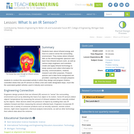
basic information about the electromagnetic waves.
- Subject:
- Physical Science
- Material Type:
- Assessment
- Author:
- raj singh
- Date Added:
- 12/07/2019

basic information about the electromagnetic waves.

Through this lesson students learn how AM radios work through basic concepts about waves and magnetic fields. Waves are first introduced by establishing the difference between transverse and longitudinal waves, as well as identifying the amplitude and frequency of a given waveform. Students then learn general concepts about magnetic fields, leading into how radio waves are created and transmitted. Several demonstrations can be performed in order to help students better understand these concepts. The goal of this lesson is for students to understand how the AM radios built during the associated activity function.

Students learn about glaucoma its causes, how it affects individuals and how biomedical engineers can identify factors that trigger or cause this eye disease, specifically the increase of pressure in the eye. Students also learn how RFID technologies transfer energy through waves and how engineers apply their scientific understanding of waves, energy and sensors to develop devices that measure the pressure in the eyes of people with glaucoma. Students conclude by sketching their own designs for a pressure-measuring eye device, preparing them to conduct the associated activity in which they revise, prototype and evaluate their device designs made tangible with a 3D printer.

In this lesson, the electromagnetic spectrum is explained and students learn that visible light makes up only a portion of this wide spectrum. Students also learn that engineers use electromagnetic waves for many different applications.

Students learn about the types of waves and how they change direction, as well as basic wave properties such as wavelength, frequency, amplitude and speed. During the presentation of lecture information on wave characteristics and properties, students take notes using a handout. Then they label wave parts on a worksheet diagram and draw their own waves with specified properties (crest, trough and wavelength). They also make observations about the waves they drew to determine which has the highest and the lowest frequency. With this knowledge, students better understand waves and are a step closer to understanding how humans see color.

Students learn about infrared energy and how it is used to sense the surrounding environment. They review where infrared falls on the electromagnetic spectrum and learn how infrared sensors work, as well as various ways engineers and scientists create and apply infrared technology to study science and collect information for security, communications, medical, research and other purposes. Pre/post-quizzes and a take-home assignment are provided. Learning the concepts prepares students to conduct the associated activity in which they design and program Arduino-controlled robots that use IR sensors to follow a line and make designated stops, much like the automated guided vehicles used in industry and commerce.